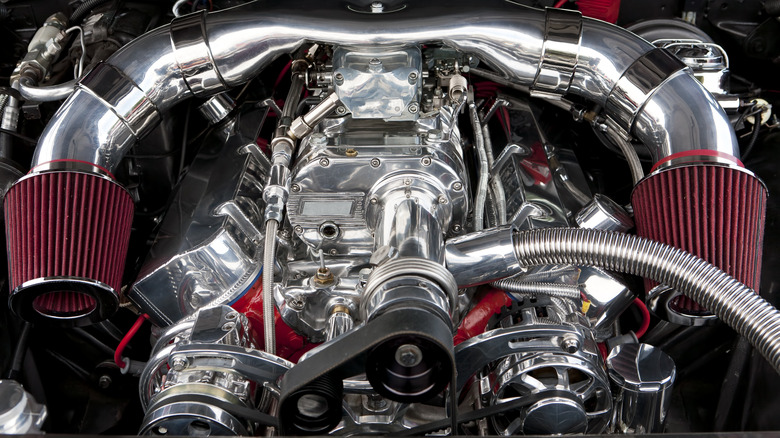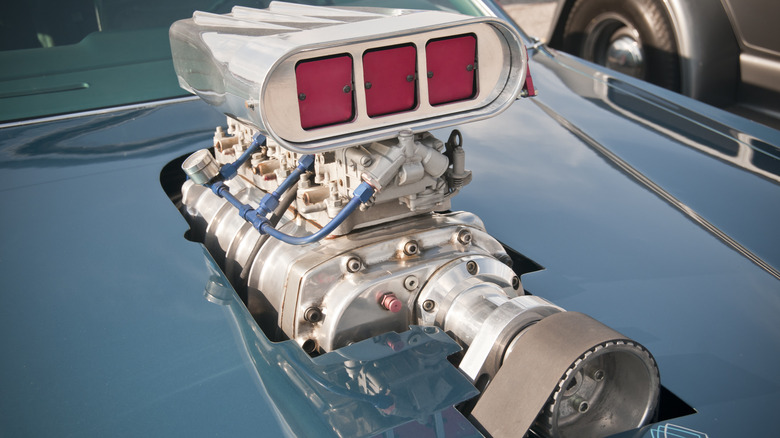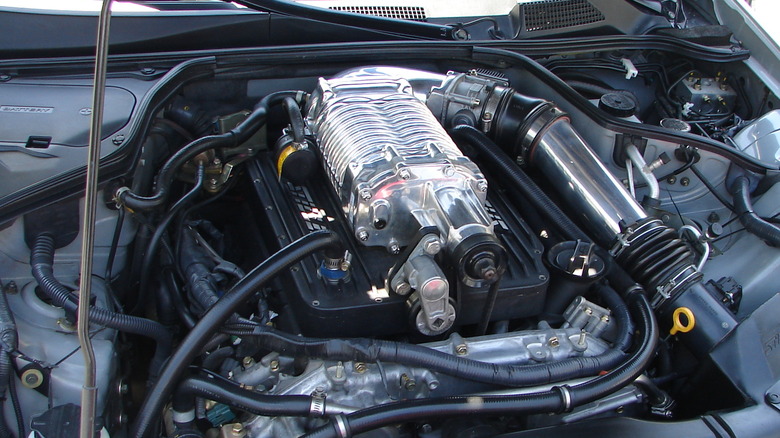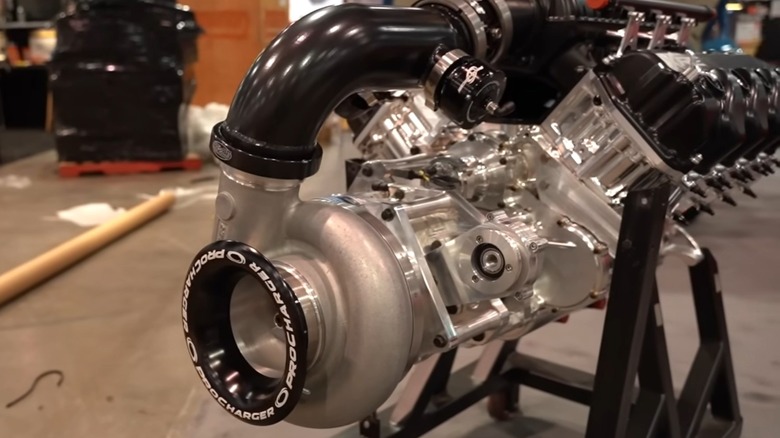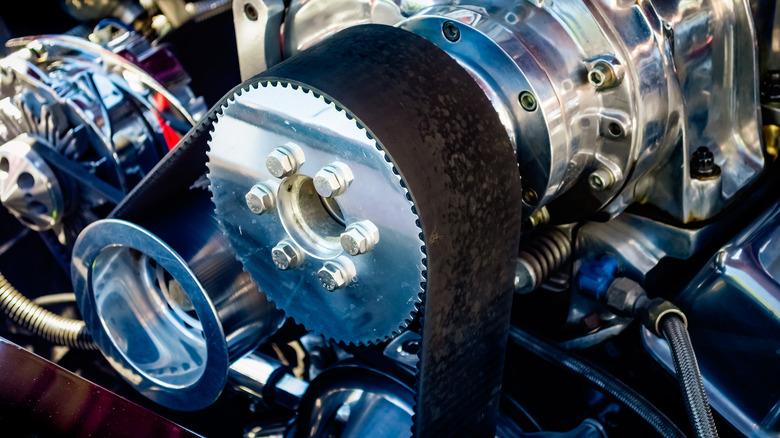Twin Screw Vs Roots Vs Centrifugal Supercharger: What's The Difference, And Which Is Best?
There are many relatively simple ways to add horsepower to your car's engine, such as installing a better intake, reprogramming the Electronic Control Unit, or swapping in a freer-flowing exhaust system. However, there's only so much these tweaks can do. If you have a serious need for speed, then forced induction via a turbocharger or supercharger is the way to go. These can add 100 or more horsepower to your engine, making even the most average engine a lot more fun to drive.
Each has pros and cons, but we're not here to wade into the supercharger versus turbocharger debate. Instead, we're here to help those of you who've decided on a supercharger to figure out the next step and choose between one of the three supercharger types available: twin screw, Roots, and centrifugal superchargers. They all do the same thing — help your engine make more power — but each works slightly differently, offering advantages and disadvantages you'll want to be aware of before committing.
Of course, if you have a lot of time and money on your hands, you could just try each type and see which works best for you and your engine — but we're guessing that most of you aren't quite that lucky. So, to help you out, here's a quick rundown and comparison of all three supercharger types.
What is a Roots supercharger?
Roots superchargers are one of the two types of positive-displacement superchargers, so named because they move a fixed amount of air per revolution. Roots superchargers sit on top of the engine, with the only moving parts being the lobes inside the housing. These are driven by a belt attached to the engine's crankshaft and move against the supercharger housing, increasing the amount of air entering the engine's intake manifold. This creates positive pressure inside the intake manifold, which compresses the air. Denser compressed air helps the engine burn fuel more thoroughly, giving you more power.
The main advantage of a Roots supercharger is its power delivery. They offer instantaneous power with a broad torque curve, with no lag or delay in the power delivery. They give your engine extra power throughout most of its rev range, only losing efficiency once you start reaching your engine's redline.
Unfortunately, the Roots supercharger is particularly prone to heat issues. First, the lobe seals that some Roots blowers use to increase efficiency also increase friction and air temperatures. Second, the Roots blower's position on top of the engine makes it susceptible to heat emanating from the engine. In both cases, the increased temperatures reduce efficiency and air density, limiting the extra power your supercharger provides. Roots blowers can also pose issues for hood clearance. Old-school-style Roots superchargers like the Weiand 671 are very tall and require you to cut a hole in your hood or run without one entirely.
What is a twin-screw supercharger?
Twin-screw superchargers are another form of positive-displacement supercharger. They share many similarities with Roots superchargers, including the top-mounted position and general concept. However, twin-screw superchargers operate slightly differently — instead of rotors that move in the same direction to squeeze air against the supercharger housing, twin-screw blowers have grooved rotors that move in opposite directions.
When in motion — which is provided, once again, by the engine's crankshaft — these two rotors mesh together and compress the air directly before it enters the engine's intake manifold. This contrasts with Roots superchargers, which function like air pumps and compress air by creating pressure inside the engine's intake manifold. The result is less leakage and power consumption with twin-screw superchargers, leading to lower air temperatures and better efficiency.
Despite the minor difference in how twin-screw superchargers work, they offer the same benefits as a Roots blower with instant, lag-free power upon acceleration in low- and mid-RPM scenarios. Like Roots superchargers, they also tail off at the top of the rev range. However, twin-screw superchargers' better efficiency and reduced heat output can give them an advantage in power output over Roots superchargers across the rev range, which increases at high RPMs.
That said, twin-screw superchargers still sit on top of your engine, which means they're still prone to heat soak from all the heat your engine produces. The improved efficiency should help here, but it's still something to watch out for. Brands like Whipple include built-in intercoolers expressly to compensate for this issue.
[Image by johnny_nissan via Wikimedia Commons | Cropped and scaled | CC BY 2.0]
What is a centrifugal supercharger?
Centrifugal superchargers are a significant departure from positive-displacement blowers. Centrifugal superchargers look and behave like turbochargers, with a high-speed impeller that creates high-speed, low-pressure air and a diffuser that converts this into a high-pressure and low-speed flow. However, centrifugal superchargers use the engine's crankshaft to move the impeller instead of exhaust gases, which a turbo uses. Either way, the result is the same: dense, compressed air that burns more fuel during combustion, creating more power.
Centrifugal superchargers are more efficient than positive displacement superchargers. They use less engine power to run and produce less heat. The small size also means you can place a centrifugal supercharger virtually anywhere in an engine bay, minimizing heat soak by moving it away from the hottest part of your engine. Unfortunately, this efficiency comes at a cost: the boost curve.
Unlike positive displacement superchargers, which generate a similar amount of boost no matter the speed, centrifugal superchargers generate more boost the higher your engine RPM. This means they don't provide the same wide-ranging power that positive-displacement superchargers provide. Instead, centrifugal superchargers work best at the top of your engine's RPM range, generating comparatively little boost at low revs. Despite that, they can make more boost overall than positive-displacement superchargers, resulting in more horsepower — just in a smaller portion of the rev range.
Centrifugal superchargers also tend to be more affordable than Roots and twin-screw superchargers. You can buy a centrifugal supercharger kit from Paxton for less than $3,000. In contrast, even the cheapest Edelbrock blower kit will set you back closer to $3,500.
Which is best for you?
There really isn't a definitive answer here, and the right supercharger for you depends entirely on what you use your car for and what you want out of your engine. If you need low to mid RPM power — for instance, for a daily-driver vehicle or a truck that requires a lot of torque at low revs — then a positive-displacement supercharger is the way to go, whether it's a Roots or twin-screw blower. They're also viable for drag cars, although turbos have become more popular for their gradual power curve and extra control options.
On the other hand, if you're happy with your engine's low-end performance or just don't need that much power at low revs, then a centrifugal unit might be the way to go. The top-end focus of centrifugal superchargers also makes them great for drag cars, as they will just keep generating boost — and thus power — the faster the car goes. The advantages of a turbo for drag racing, namely the gradual power curve, apply here too.
